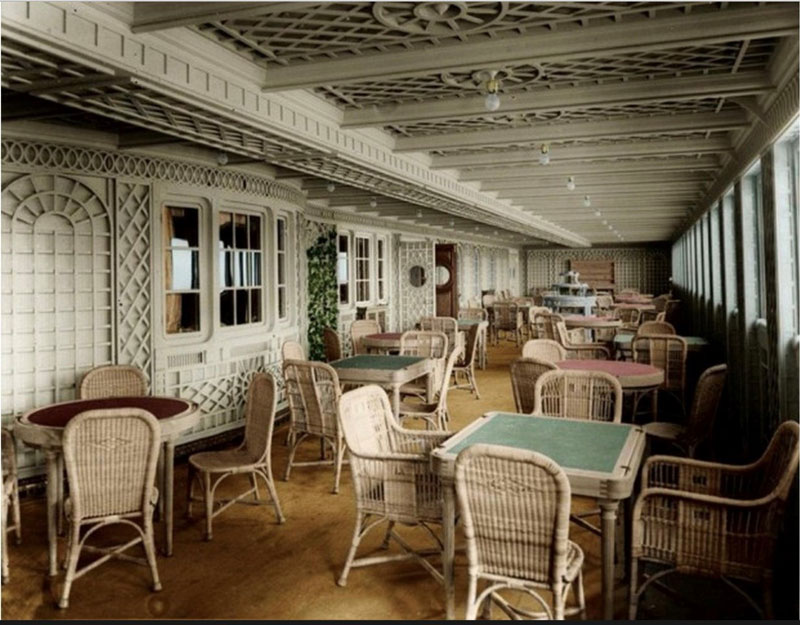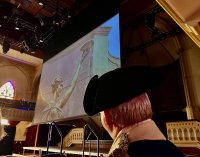Photos provided.
April 15 marks the occasion of the most renowned disaster in the annals of Maritime History.
At 11:40 p.m. on April 14, 1912 The RMS Titanic, the largest passenger ship in the world, hit an iceberg in the frigid waters of the North Atlantic. Less than three hours later she would disappear beneath the waves and into history. This story has been told and retold. Numerous books, movies, and documentaries have chronicled every second of her four day existence.
Let’s take a brief look at the legendary Titanic. It was the dawn of the Twentieth Century. Man’s ingenuity was reaching dizzying heights. Buildings were touching the sky. The tallest structure in the world, the Woolworth Building in New York City, rose to a breathtaking height of 792 feet. Trains were being built larger and more powerful than ever. With that came longer bridges, faster travel times, and superior accommodations.
The shipping business was no exception. Great Britain was at the pinnacle of it’s power. No construction feat seemed beyond her reach. The new found riches of an America that was rapidly growing into a world power demanded opulence for the weathly businessmen who had financial interests on both Continents.
A British shipping firm, White Star Lines, had them distinctly in mind when they made plans to acquire the two largest passenger ships in the world. The actual building of the ships was contracted to Harland and Wolff, Britain’s premier shipbuilder.
The sisters were christened with the names Olympic and then soon after Titanic. Olympic made her maiden voyage in 1911. With the completion of the Titanic a year later, White Star would have one ship leaving Southampton, England weekly. From the states the other would leave New York Harbor, creating the perfect ocean-going ferrying system between the two continents.
Both stood almost 900 feet long. They weighed in at an astounding 45,000 tons. Their main public rooms were steeped in luxury. The suites and staterooms of first class were extaordinary. The finest wines and fare were purveyed for the discerning guests who would frequent the first class dining room. For those who wanted to have dinner in an even more reserved setting, patrons could opt for the À La Carte Restaurant. Here, a ten course dinner would await the palate of its demanding clientele.
Titanic would see some upgrades that separated her from her luckier sister. Thomas Andrews, Harland and Wolff’s principal architect in charge of shipbuilding added an indoor pool. More of a novelty, it did add to the mystique of the ship. He also partially enclosed the promenade deck. It allowed first class passengers the option to stroll the deck with no concern of the brutal weather conditions found in the North Atlantic in the winter months. On that same deck, Café Parisian, an authentic French Eatery, was created with a splendid view of the ocean. Serving the same culinary delights of the À La Carte Restaurant, it was an immediate favorite of the first class passengers.
Although Titanic was surely catering to the rich, her bread and butter was the poor. The majority of her passengers were the European immigrants looking for a better life in America. They would account for more than half of Titanic’s passsengers. In stark contrast to the wealthy, theirs would be a rather mundane experience. The hope of a new world and all of it’s possibilities was their main attraction to the ship. Many of them would never realize their dream of sailing through the Verrazano Narrows and the gateway to America.
On April 11, 1912, Titanic was set to embark. This being her maiden voyage, the dock was crowded with workers and well wishers. The Senior Captain of White Star Lines, Edward J. Smith, known as E.J., was at the helm. He had an impeccable forty-year career and was considered the finest pilot of passenger ships on the high seas. On this, his last voyage, he would be tested to his outer limits.
ICEBERG DEAD AHEAD
The first three days of the voyage were rather uneventful. Titanic and Olympic did pass each other for the first and only time in mid-ocean. On her fourth day she was about to become legendary. Survivors on board that night stated that it was the calmest sea that they had ever seen. It has been noted that this phenomenon made it difficult for the ship’s lookouts to spot the ice. This, along with the unfortunate fact that they were without binoculars. Yes, inexplicably they were never brought aboard the ship. These, along with unheeded messages that warned of an icefield along the route were important factors in Titanic’s demise. By the time the iceberg was spotted, it was too late. The officer on the bridge made the decision to veer hard to starboard to evade the berg. It had no such effect. In fact, it proved to be the deathknell of the vessel. As Titanic veered past the massive piece of ice, the side of the berg sliced a three hundred foot gash below the waterline of the ship. Captain Smith sent Andrews, the ship’s architect below decks to check on her condition. He came back with the worst possible news. The Titanic was mortally wounded. After making some mathematical equations, he gave her no more than two hours to live. Smith then swung the ship’s crew into action. The Marconi Wireless operators signaled an SOS to all ships in the vicinity. None could reach her in less than four hours. All passengers were told to put on life jackets and make their way to the boat deck.There was one problem, there were not enough lifeboats. There were a total of two thousand and three hundred passengers and crew.
The boats, fully loaded, could carry about one thousand. To add to the problem, the first of the boats were sent off half full. Rockets were fired to alarm any ship nearby that Titanic was in dire straights. The gravity of the situation began to unfold. The Titanic was about to sink.
A who’s-who list of America’s wealthiest individuals were now faced with an unforeseen end. They included John Jacob Astor. His massive fortune was at this moment of no consequence to him. He seated his pregnant young wife on a lifeboat, calmly lit a cigarette, and walked away from the boat.
Isadore Straus, owner of Macy’s Departmeny Store, and his wife were also passengers. Mrs. Strauss refused a seat on a lifeboat, stating to her husband, “We have lived together for many years...Where you go, I go.” They too perished with the ship.
Arthur Ryerson, owner of one of the largest steel companies in the United States, was also on board. As fate would have it, his son died in an automobile accident back home shortly before Titanic sailed. Ryerson and his heartbroken family booked passage on the ship. He would not live to bury his son. He too was a casualty of “A Night To Remember” as author Walter Lord so perfectly phrased it.
TITANIC’S CONNECTION TO SARATOGA
There were also those with connections to Saratoga on board. George Denton Widener, the patriarch of Philadelphia’s wealthiest and most influential family, was a passenger. Both Widener and his son Harry perished in the disaster. His brother Joseph and son George became scions of the Sport of Kings. Joseph Widener was the original owner of Hialeah Park and for many years had a controlling interest in Belmont Park. George D. Widener Jr. was a part of the Saratoga Racing Scene for over forty years. His horses prevailed in no less than five runnings of The Traver’s Stakes.
Benjamin Guggenheim was also a passenger. His nephew Harry became the proprietor of Cain Hoy Stable, a major horse racing operation in the Golden Age of the sport. Captain Harry, as he was known was also a fixture at the Spa for many years. His Uncle Benjamin went down with the chivalry one could only expect from a true gentlemen. When informed that it looked like it was curtains down for him and his valet, they headed back to their rooms, changed into dinner clothes, and headed to the main deck. Mr. Guggenheim asked someone entering a boat to transmit to his wife that “We have dressed in our finest... and are prepared to go down as gentlemen.”
Alfred Gwynn Vanderbilt was one of the lucky ones. The owner of The New York Central Railroad changed plans and cancelled his trip on Titanic. His good luck was fleeting. Three years later he was onboard the ill-fated Lusitania. The ship was torpedoed by a German U Boat off the coast of Ireland. She would sink in less than thirty minutes. In a grand gesture Vanderbilt gave his lifejacket to a woman passenger. As he well knew he could not swim, this effectively sealing his doom. His son Alfred became a major player on the American Horse Racing Scene. He made Saratoga his summer home for more than five decades.
Of note to racing fans: The aforementioned Harry Guggenheim beat Alfred Vanderbilt”s great champion Native Dancer with longshot Dark Star in the 1953 Kentucky Derby. Both Alfred Vanderbilt and George Widener were unsuccessful in their attempts to win the Derby, despite racing some of the greatest horses of the twentieth century.
J.P. Morgan, America’s wealthiest financier, and owner of White Star Line also escaped eating sand. He cancelled plans to make the crossing on the ship shortly before Titanic sailed.
Some of the elite did manage to get into lifeboats. The name that lives on in infamy is that of Bruce Ismay. He was the managing director of White Star Line. Sadly he chose to board one of the first lifeboats. His reputation forever sullied, he lived the rest of his life in a self-inflicted seclusion.
THE LEGEND NEVER DIES
The Titanic disaster was fertile ground for legend. The largest, most beautifully appointed, passenger ship in the world had hit an iceberg and sank. Many of the world’s wealthiest and most accomplished businessmen were onboard. There were not enough lifeboats to accomodate the passengers and crew. Warnings of ice in the area were brushed aside. Acts of bravery added to the legend. Here is just one of many. The ship’s band took it upon themselves to calm the frightened passengers with well-known tunes of the time. They continued to play their instruments until the final moments. Fifteen hundred passengers and crew disappeared into a watery grave. Only eight hundred survived the calamity.
No writer of fiction could ever fashion a more poignant drama than the reality of Titanic’s last night. The great ship was struck from the British Registery as of 2:20 a.m.., April 15, 1912. One hundred and seven years, later the Legend continues to live on.































 How to resolve AdBlock issue?
How to resolve AdBlock issue? 









